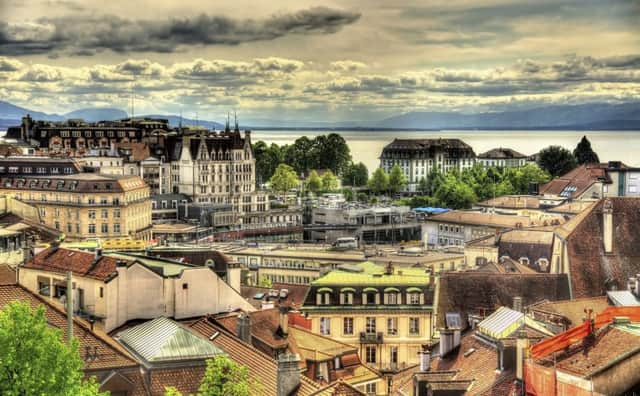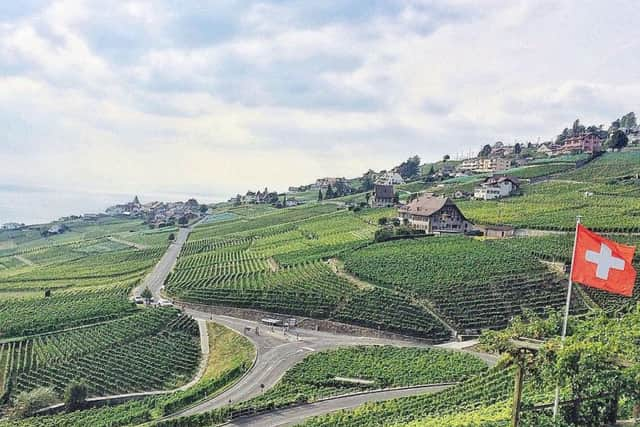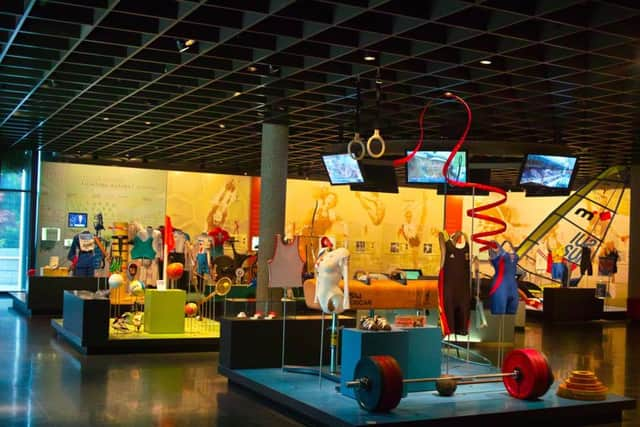Travel: Lausanne, Switzerland


It is, our guide tells us while adjusting her scarf, unseasonably warm for the time of year. We’re standing in the shadows of Lausanne’s Cathédrale de Notre-Dame, on a Friday night, as the time nears 10pm.
The clock strikes and a figure in a wide-brimmed hat appears at a balcony at the top of the tower carrying a lantern. This is Renato Häusler, Lausanne’s lookout. Between 10pm and 2am every night, he shouts the time on the hour four times (once each for North, South, East and West), carrying on a 700-year-old tradition. Originally a device to warn the townsfolk of fire, it’s now a tribute to a bygone era, with just a handful of European cities maintaining a watchman.
Advertisement
Hide AdThe autumn sunshine that greets us the following morning bathes Lausanne in a bright, warm light, and it feels more like June than the tail end of September as we wander the streets and get our bearings. Overhead, a biplane belonging to the Breitling watch firm cruises over Lake Geneva against a backdrop of the Alps and a clear blue sky. It’s almost as if Switzerland is showing off.


Lausanne is the birthplace of tennis player Stanislas Wawrinka (even though people seem more taken by Roger Federer) and the resting place of Coco Chanel. There’s even a church called the Scots Kirk, founded in 1876 and dedicated to Saint Andrew, while the International Olympic Committee is also based here. For a city of just 134,000 people, there’s a lot more to Lausanne than meets the eye.
Built on a slope, the city’s lowest elevation is on the banks of Lake Geneva, at 372m above sea level, stretching up to Jorat, at 924m. It feels like a young city, despite being situated on the site of a Celtic settlement that was built on by the Romans. That’s due in part to the number of students, who make up around 10 per cent of the city’s population.
We start a busy 48 hours with a walking tour of the city. It’s market day, and dozens of political parties are handing out badges, balloons and leaflets in the streets near the town hall. The Pirate Party have drawn the largest crowd, while an anti-immigration party official jabs a finger at a dissenting passer-by. The crowded Place de la Palud is a riot of colour and noise, and after a quick stop for some fondue – a local speciality – we move on to the centre of Lausanne’s nightlife.
Named for the river that used to flow through the centre of Lausanne, the Flon region has evolved from a series of low-rent offices and dilapidated warehouses to a regenerated, award-winning area. Among the many nightclubs is the renowned Mad! Club, while some enterprising individuals are setting up pop-up bars in the arches under one of the city’s main bridges. Later that night we return to Flon for a few drinks, noting the scores of people heading to the nightclubs from the nearby Metro station.


The Flon area is a short walk from the impressive Brasserie de Montbenon, which deals in locally sourced food from the Vaud region and is well worth a visit for traditional Swiss fare. Those after an aperitif should seek out the trendy Yatus wine bar, slap bang in the city centre, which has a wonderful selection of Chasselas wines from the nearby vineyards, and a wide selection of Swiss beers.
Advertisement
Hide AdOur weekend in Lausanne coincides with the one weekend of the year when the city’s museums open from 2pm until 2am. With our time limited, we scan the programme and decide to go to the Collection de l’Art Brut, or “outsider art”. The museum houses works created by individuals with autism, schizophrenia and other disabilities. It’s powerful and unsettling, and not just because of the discordant music seeping through from a nearby room or the fact that it’s 11.30 at night. It’s an astonishing collection of remarkable creativity and emotion, both challenging and thought-provoking.
A short train journey from Lausanne are the vineyards. The city itself is nestled between the La Côte and Lavaux wine growing regions, and we take a trip to the former. A Unesco World Heritage Site, Lavaux has been the site of wine growing since the 11th century. Stretching for over 800 hectares, the steeply terraced vineyards run for around 30km, overlooking Lake Geneva. We visit the Domaine Croix Duplex, which has been making wine for nearly 100 years. Today, the vineyard produces 26 different varieties, and we’re lucky enough to try a few, sitting on the terrace overlooking the vineyards, the village of Grandvaux, and the lake.
Advertisement
Hide AdBut the wine-tasting is over all too quickly, and after a hair-raising scramble down the hillside to Cully, we board a tourist train for a trip round the many vineyards. It really is breathtaking – the steepness of the hill with the Alps looming in the near distance, with the odd Swiss flag billowing gently in the breeze among row upon row of grapevines.


Then it’s back to Cully to board a paddle-steamer ship back to Lausanne. It’s a bit too breezy to take in the lake from the deck, but a window seat inside offers us an unrivalled view of the shoreline. A short walk from the harbour at Lausanne is the Olympic Museum – a sprawling complex charting the games from their inception until the present day. There’s an entire section dedicated to the torches of both winter and summer games, information charting the history of Olympic mascots, a suitably extravagant exhibit focusing on the lavish opening ceremonies, and a reminder of home with Chris Hoy’s cycling outfit included among the clothing display. There’s a lot to take in, but it doesn’t ever feel overwhelming thanks to the innovative and interactive exhibits.
It’s only when we’re on the train back to Geneva to catch our flight home that I realise we’ve barely scratched the surface of Lausanne.
For a city of just 16 square miles, there are so many stories crammed into the steep streets along with a rich history and culture that deserve far more time and attention than we are able to give them.
I’ll avoid the tired cliché about good things and small packages. But Lausanne could be one of the best wee cities in Europe.